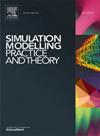Peridynamics simulating of dynamics crack propagation in rock mass under blasting load
IF 3.5
2区 计算机科学
Q2 COMPUTER SCIENCE, INTERDISCIPLINARY APPLICATIONS
引用次数: 0
Abstract
It is important to study the crack propagation and failure criterion of fractured rock masses under dynamic blasting loads to ensure the safety and stability of tunnels constructed using the drill-and-blast method. Based on the idea of conventional peridynamics, a peridynamics constitutive model of the pull-compression composite failure of rock materials and a peridynamics simulation method for crack propagation in a fractured rock mass under a blasting load were established. In addition, the criterion for the stress wave incident angle and in-situ stress state for crack propagation in a rock mass were investigated. The incident angle of the stress waves was found to affect the crack propagation. When the incident angle was 0°, new cracks propagated parallel to prefabricated cracks. When the incident angle was 15°-75°, wing cracks formed at the tips on both sides of a prefabricated crack, and the initiation and propagation angles of these new cracks increased with the incident angle. The in-situ stress affected the propagation direction of an explosive-generated crack and the range of the fracture zone. When unidirectional stress was applied, the radial main crack expanded along the direction of the stress, and the range of the fracture zone decreased with an increase in stress. The applicability and accuracy of the proposed dynamic disturbance peridynamics simulation method for solving the problem of dynamic failure and crack growth in a rock mass were verified based on previous physical and model test results.
爆破荷载作用下岩体动态裂纹扩展的周动力学模拟
研究裂隙岩体在动爆破荷载作用下的裂纹扩展规律和破坏准则,对保证钻爆法隧道的安全稳定具有重要意义。基于常规周动力学思想,建立了岩石材料拉压复合破坏的周动力学本构模型和爆破荷载作用下裂隙岩体裂纹扩展的周动力学模拟方法。此外,还研究了岩体裂纹扩展的应力波入射角判据和地应力状态判据。发现应力波的入射角对裂纹扩展有影响。当入射角为0°时,新裂纹平行于预制裂纹扩展。当入射角为15°~ 75°时,预制裂纹两侧尖端处形成翼状裂纹,新裂纹的起裂角和扩展角随入射角的增大而增大。地应力影响爆炸裂纹的扩展方向和破裂带的范围。单向应力作用下,径向主裂缝沿应力方向扩展,破裂带范围随应力的增大而减小。基于已有的物理试验和模型试验结果,验证了所提出的动态扰动周动力学模拟方法在求解岩体动态破坏和裂纹扩展问题中的适用性和准确性。
本文章由计算机程序翻译,如有差异,请以英文原文为准。
求助全文
约1分钟内获得全文
求助全文
来源期刊

Simulation Modelling Practice and Theory
工程技术-计算机:跨学科应用
CiteScore
9.80
自引率
4.80%
发文量
142
审稿时长
21 days
期刊介绍:
The journal Simulation Modelling Practice and Theory provides a forum for original, high-quality papers dealing with any aspect of systems simulation and modelling.
The journal aims at being a reference and a powerful tool to all those professionally active and/or interested in the methods and applications of simulation. Submitted papers will be peer reviewed and must significantly contribute to modelling and simulation in general or use modelling and simulation in application areas.
Paper submission is solicited on:
• theoretical aspects of modelling and simulation including formal modelling, model-checking, random number generators, sensitivity analysis, variance reduction techniques, experimental design, meta-modelling, methods and algorithms for validation and verification, selection and comparison procedures etc.;
• methodology and application of modelling and simulation in any area, including computer systems, networks, real-time and embedded systems, mobile and intelligent agents, manufacturing and transportation systems, management, engineering, biomedical engineering, economics, ecology and environment, education, transaction handling, etc.;
• simulation languages and environments including those, specific to distributed computing, grid computing, high performance computers or computer networks, etc.;
• distributed and real-time simulation, simulation interoperability;
• tools for high performance computing simulation, including dedicated architectures and parallel computing.
 求助内容:
求助内容: 应助结果提醒方式:
应助结果提醒方式:


